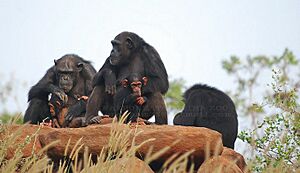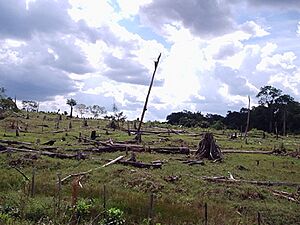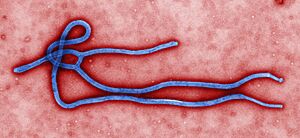Central chimpanzee facts for kids
Quick facts for kids Central chimpanzee |
|
|---|---|
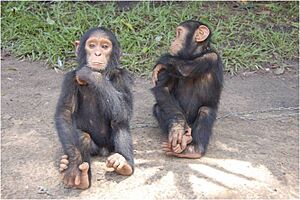 |
|
| Conservation status | |
| Scientific classification |
|
| Kingdom: | Animalia |
| Phylum: | Chordata |
| Class: | Mammalia |
| Order: | Primates |
| Suborder: | Haplorhini |
| Infraorder: | Simiiformes |
| Family: | Hominidae |
| Subfamily: | Homininae |
| Tribe: | Hominini |
| Genus: | Pan |
| Species: | |
| Subspecies: |
P. t. troglodytes
|
| Trinomial name | |
| Pan troglodytes troglodytes Blumenbach, 1775
|
|
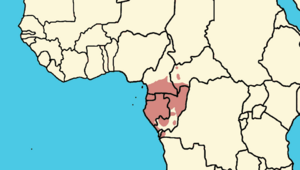 |
|
The central chimpanzee (Pan troglodytes troglodytes) is a type of chimpanzee. You can find them in Central Africa. They mostly live in countries like Gabon, Cameroon, the Republic of the Congo, and the Democratic Republic of the Congo.
Central chimpanzees are very smart apes. They live in large social groups, often with a male as the main leader. These chimpanzees are known for using tools. For example, they might use sticks to get ants or termites, or stones to open nuts.
These chimpanzees are important for the health of rainforests. They help spread seeds when they eat fruit and then move around. This helps new plants grow. Even though central chimpanzees and western lowland gorillas live in the same areas, they don't usually fight over food because they eat different things.
Sadly, the International Union for Conservation of Nature (IUCN) says that central chimpanzees are an endangered animal. This means their numbers are shrinking. Things like cutting down forests (deforestation) and certain viruses are big dangers to them.
Contents
Where They Live
Central chimpanzees mostly live in the rainforests of Gabon, Cameroon, and the Republic of the Congo. You can also find them in the Central African Republic, Equatorial Guinea, a small part of Angola called Cabinda, and southeast Nigeria. Their home range stretches from the Sanaga River in Cameroon to the Ubangi River and Congo River.
These chimpanzees prefer to live in tropical moist forests and wet savanna woodlands. They can live from sea level up to about 3,000 meters (nearly 10,000 feet) high. Their living areas can be quite large, sometimes up to 400 square kilometers (about 150 square miles).
What They Look Like
Male central chimpanzees usually weigh about 59.7 kilograms (132 pounds) and stand about 96 centimeters (38 inches) tall. Females are a bit smaller, weighing around 45.8 kilograms (101 pounds) and standing about 80 centimeters (31 inches) tall.
In zoos or sanctuaries, central chimpanzees can live for 30 to 40 years, and some even live over 50 years! In the wild, they usually live for 15 to 25 years. One way to tell them apart from other chimpanzees is that they have less hair on their faces, especially the females. They also have longer arms and fingers, but shorter thumbs. These features help them climb trees very well.
How They Behave
Social Life
Central chimpanzees live in social groups that can have around 66 individuals. These groups are often larger than those of western chimpanzees. In these groups, male chimpanzees are usually in charge. The strongest and most active males often become the "alphas" or leaders of the group. Females can also have important roles as "alpha females," though they usually don't outrank the alpha males.
Chimpanzees spend their time doing four main things: looking for food, socializing, moving around, and resting. In the wild, they spend about half their day searching for food. The rest of their time is split evenly between socializing, moving, and resting.
Sometimes, these large groups break into smaller "parties," often made up mostly of males. These smaller groups control certain areas. This can sometimes lead to fights between different chimpanzee groups, which can even cause deaths.
Their Role in Nature
Central chimpanzees play a very important role in the rainforest environment. They are excellent seed dispersers. This means they help spread seeds around. Since they eat a lot of fruit, they can't digest the seeds. When they poop, these seeds are dropped onto the forest floor. The seeds even get a special "treatment" in the chimpanzee's gut that helps them grow better. Because of this, central chimpanzees are vital for keeping the rainforest healthy.
What They Eat
Central chimpanzees mostly eat fruit. They are known as "frugivores." Even when there isn't much fruit available, they try to eat as much as they can. They often stay in the trees and plants to find their food.
While central chimpanzees and western lowland gorillas both eat a lot of fruit in Central Africa, chimpanzees eat more fruit (about 60% of their diet). Gorillas also eat more leaves. This means they don't usually compete for the same food. Central chimpanzees have even been seen eating certain leaves for medical reasons, possibly to help with stomach parasites. They also sometimes hunt other animals, like the red colobus monkey, but this is rare.
Protecting Them
The International Union for Conservation of Nature (IUCN) has listed the central chimpanzee as endangered since at least 1996. The World Wildlife Fund (WWF) thinks there might be between 47,000 and 78,000 central chimpanzees left. Large groups of these chimpanzees only survive where big parts of the forest are left untouched. Sadly, the IUCN expects their numbers to keep going down for many more years.
The biggest threats to central chimpanzees are diseases like Ebola virus disease, poaching (illegal hunting) for bushmeat, and habitat destruction. This destruction happens because humans are expanding farms, cutting down forests, and building new things. Political problems in the region also make it harder to protect them.
Because chimpanzees are closely related to humans, they can catch many of the same viruses that affect people. This includes Ebola, the common cold, flu, and measles. They can also get other diseases from parasites.
Diseases Affecting Chimpanzees
Heart Problems
One of the main causes of death for central chimpanzees is heart disease. This can cause their hearts to stop suddenly. It's hard for scientists to figure out why this happens after a chimpanzee dies. However, studies have shown that kidney failure and injuries can sometimes lead to these heart problems.
Ebola Virus
Since the 1990s, there have been many outbreaks of the Ebola virus among great apes, especially central chimpanzees, across Africa. This has greatly reduced their populations. Ebola has also spread to western lowland gorillas and even to humans.
For example, in 1994, an Ebola outbreak caused 25% of the central chimpanzee population in one rainforest to die in just a few weeks. This meant 43 wild chimpanzees died in the Tai National Park. Ebola often spreads between western lowland gorillas and central chimpanzees. Since the 1990s, it's believed that about one-third of the populations of both western lowland gorillas and central chimpanzees have died from Ebola.
Another outbreak in 1996 in Gabon showed that central chimpanzees had a very high risk of dying if they caught the virus. Out of 37 infected chimpanzees, 27 died. The danger from Ebola, combined with habitat loss, is a huge problem for central chimpanzee numbers.
In 2004, another Ebola outbreak in Central Africa had a massive impact. In one area, the western lowland gorilla population dropped from 380 to just 40 individuals. This outbreak also caused a big drop in the central chimpanzee population. This virus clearly has a drastic effect on their numbers.
Ebola Vaccine Research
In 2011, scientists started an experiment to try and vaccinate central chimpanzees against Ebola. They used a vaccine made for humans on six chimpanzees. The goal was to see if they could stop the spread of Ebola among chimpanzees. The chimpanzees seemed to develop a defense against the virus, creating special antibodies. However, this study was not fully finished. In 2015, central chimpanzees were put on the endangered list, which meant further experiments had to be stopped.
HIV and Chimpanzees
There are two main types of human immunodeficiency virus (HIV) that affect humans: HIV-1 and HIV-2. HIV-1 is the more common type worldwide. Both types originally came from West and Central Africa. Scientists have found that HIV-1 developed from a similar virus called SIVcpz, which is found in central chimpanzees.



